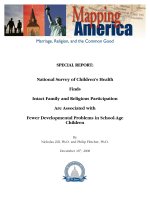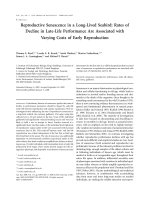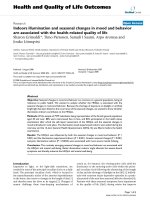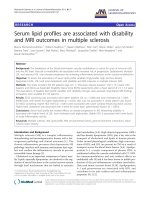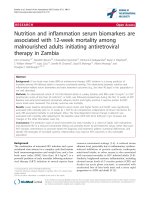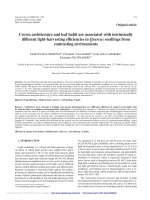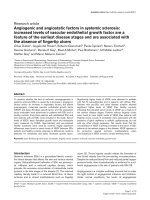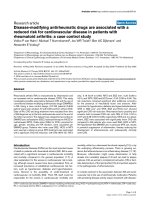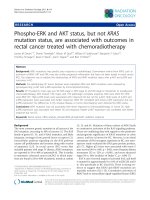EcoTILLING by sequencing reveals polymorphisms in genes encoding starch synthases that are associated with low glycemic response in rice
Bạn đang xem bản rút gọn của tài liệu. Xem và tải ngay bản đầy đủ của tài liệu tại đây (1.18 MB, 13 trang )
Raja et al. BMC Plant Biology (2017) 17:13
DOI 10.1186/s12870-016-0968-0
RESEARCH ARTICLE
Open Access
EcoTILLING by sequencing reveals
polymorphisms in genes encoding starch
synthases that are associated with low
glycemic response in rice
Ramadoss Bharathi Raja1,2, Somanath Agasimani1, Sarita Jaiswal2, Venkatesan Thiruvengadam1, Robin Sabariappan1,
Ravindra N. Chibbar2 and Sundaram Ganesh Ram1*
Abstract
Background: Glycemic response, a trait that is tedious to be assayed in cereal staples, has been identified as a
factor correlated with alarmingly increasing prevalence of Type II diabetes. Reverse genetics based discovery of
allelic variants associated with this nutritional trait gains significance as they can provide scope for genetic
improvement of this factor which is otherwise difficult to target through routine screening methods.
Results: Through EcoTILLING by sequencing in 512 rice accessions, we report the discovery of six deleterious
variants in the genes with potential to increase Resistant Starch (RS) and reduce Hydrolysis Index (HI) of starch.
By deconvolution of the variant harbouring EcoTILLING DNA pools, we discovered accessions with a minimum
of one to a maximum of three deleterious allelic variants in the candidate genes.
Conclusions: Through biochemical assays, we confirmed the potential role of the discovered alleles alone or in
combinations in increasing RS the key factor for reduction in glycemic response.
Keywords: EcoTILLING by sequencing, Allele mining, Glycemic response, Rice, Resistant starch, Starch biosynthesis
Background
Rice is the most important cereal staple for more than
half the world’s population. As a primary dietary source
of carbohydrates, it plays an important role in meeting
energy requirements and nutrient intake among the rice
eating populations [1]. Cooked rice is readily digested
because it contains higher proportions of digestible
starch (DS) and a lower RS [2]. RS has been reported by
many studies to play an inhibitory role in the interaction
of α amylase a predominant starch metabolising enzyme
in human gut, with the carbohydrates in many cereals
including rice resulting in slow digestibility of starch [3].
RS in cereal grains is reported to be the functional equivalent of dietary fibre through many animal studies [4–7].
* Correspondence:
1
Centre for Plant Breeding and Genetics, Tamil Nadu Agricultural University,
Coimbatore 641 003, Tamil Nadu, India
Full list of author information is available at the end of the article
In the past, dietary carbohydrates have been derived
from whole coarse grains of rice, which were loaded with
sufficient dietary fibre. At present, they are replaced predominantly with milled white rice carbohydrates devoid
of any dietary fibre [8–10]. Studies involving human subjects related to the assessment of the causative factors
for high prevalence of type II diabetes in Asia had indicated the consumption of milled white rice as one of the
major factor [11–13]. The uninhibited interaction of α
amylase with the carbohydrates from milled white rice
leading to rapid release of glucose in the blood stream
was demonstrated as the mechanism for diabetes incidence in many animal studies [6, 14–17].
Increasing the RS levels in the endosperm of cereal
staples including rice is envisaged as an essential target
for quality improvement of their starch in the context of
human health [18]. Characterisation studies of cereal
starches with high RS had indicated two major biochemical
components to be positively associated with this desirable
© The Author(s). 2017 Open Access This article is distributed under the terms of the Creative Commons Attribution 4.0
International License ( which permits unrestricted use, distribution, and
reproduction in any medium, provided you give appropriate credit to the original author(s) and the source, provide a link to
the Creative Commons license, and indicate if changes were made. The Creative Commons Public Domain Dedication waiver
( applies to the data made available in this article, unless otherwise stated.
Raja et al. BMC Plant Biology (2017) 17:13
fraction. Studies of Miller et al. [19], Leeman et al. [20] and
Lehman and Robin [21] had provided conclusive evidences
for positive correlation of amylose with RS enhancement.
While other characterisation studies in cereals had demonstrated that increased proportion of short chains and
decrease in intermediate and long chain amylopectin also
play a vital role for increase in RS content [22].
In rice, it is surprising to note that many of the indica
varieties in spite of their intermediate to high amylose
content (AC) (20–30%) in their grains do not show
much reduction in their starch digestibility and remains
rapid in their glycemic response [23]. Findings of Chung
et al. [24] based on their study of rice varieties with varied
amylose contents clearly indicated that apart from AC the
higher proportion of short chain amylopectin is also a
critical factor for reduction in digestibility of starch. This
warrants the need for exploration of rice varieties with
high AC along with increased proportion of short chain
amylopectin to reduce its glycemic response.
Natural allelic variants are more stable in their expression as compared to induced mutations, as they are
generated and stabilised over their long course of evolution
[25]. The classical example of isolation and use of path
breaking natural gene variants is the discovery of dwarfing
genes such as Dee-geo-woo-gen in rice and Norin 10 in
wheat which led to the green revolution during 1960s [26].
Recently, the isolation of sub-1 gene leading to the
development of submergence tolerant rice varieties is
also a demonstration of the discovery and use of natural
allelic variants from germplasm [27]. As the natural
variants occur in an extremely low frequency, the power
of allele mining to discover them has to be enhanced by
applying modern genomic tools. Genomics assisted allele
mining approaches when applied in reverse genetic mode
results in enhanced power of detection and provides scope
for high throughput screening of large germplasm in a
short time frame [28]. Isolation of natural sequence allelic
variants in targeted candidate genes has been successfully
demonstrated through EcoTILLING in many plants
such as Arabidopsis [29], banana [30], Populus [31], field
bean [32], mung bean [33], barley [34], potato [35],
Cucumis spp [36], tomato [37], Sugar beet [38] and also
in rice [39].
The conventional TILLING and EcoTILLING methods
using CELI endonuclease based heteroduplex cleavage are
less effective and labour intensive, hence very challenging
in employing them in large mutant and germplasm DNA
pools. To overcome the difficulties of conventional TILLING approach, Tsai et al. [40] demonstrated TILLING by
high throughput sequencing in large mutant populations of rice and wheat. Recently, TILLING by sequencing was also been employed for the identification of
allelic variants responsible for abiotic and biotic resistance
in peanut [41].
Page 2 of 13
In the present investigation, we employed EcoTILLING by sequencing of candidate genes for the discovery
of potential nucleotide variations associated with low
glycemic response in rice. Our candidate gene selection
was based on the studies of Sestili et al. [42], Regina et
al. [43] and Satoh et al. [44] in wheat, barley and rice
mutants generated through gene silencing and knock
out technologies. These studies reported many potential
loss of function mutations in the genes coding for Starch
Synthases (SS) and Starch Branching Enzymes (SBEs)
associated with the enhancement of RS.
Results
Variant discovery through EcoTILLING by sequencing
To identify the natural allelic variants in the starch biosynthesis genes of rice, we performed EcoTILLING by
sequencing in 512 indica rice germplasm accessions
representing landraces, breeding lines, cultivars and
exotic collections (Additional file 1: Table S1). The identified EcoTILLING regions in all the six candidate genes
with high probability to harbour variants as indicated by
their high Position Specific Scoring Matrix (PSSM) difference were presented in Table 1. The position and the
length of the EcoTILLING fragments of all six candidate
genes were indicated in Fig. 1. EcoTILLING fragments
were successfully amplified using targeted primers
(Additional file 1: Table S2) through touch down PCR
to minimize the off target amplifications as recommended
by Don et al. [45] (Fig. 2). Various cycling conditions and
master mix combinations were optimised for different
candidate genes (Additional file 2: Table S4, Additional
file 3: Table S5). The amplified PCR products were
cleaned up and pooled to produce 16 libraries. The libraries were individually bar-coded, pooled and sequenced
to assess the variants.
The average reads generated by Ion Proton sequencing
from 16 super pooled DNA libraries varied from 2.20 to
6.96 million, with average read length varying from 81 to
98 bp. (Additional file 4: Table S6). The average depth of
coverage per accession was 264.09, which had surpassed
the suggested minimum reads of 10 X [40] per base indicating the variants discovered in this investigation possess very high confidence limits.
From 20.4 kb of EcoTILLING regions spanning in six
candidate genes, 72 (60 SNPs and 12 single base Indels)
natural variants were discovered (Additional file 5:
Table S7). Out of the 60 SNPs, transitions accounted
for 13 numbers each of T → C and G → A, followed by
eight numbers of A → G, and six numbers of C → T.
Seven transversions each of T → G and C → A followed
by three numbers of T → A, two of G → C and one of
A → C were observed. All the 12 single base Indels discovered were deletions.
Gene
GBSS I
SS I
SS IIa
SS IIIa
SBE Ia
SBE IIb
S.
No
1.
2.
3.
4.
5.
6.
D16201.1
GQ150912.1
GQ151010.1
GQ150968.1
GQ150950.1
AB425323.1
mRNA ID
NCBI Genbank
NC_008395.2
NC_008399.2
AK061604
NC_008399.2
NC_008399.2
NC_008399.2
Genomic ID
10.899
4.745
11.083
4.419
6.815
3.479
Gene
size (kb)
3517 to 4815
923 to 2221
8887 to10185
3037 to 4335
4550 to 5848
1679 to 2977
Gene area of
highest
PSSM Score
difference
1711
2384
3203
3346
1708
2782
PSSM
Score
difference
2
1
2
2
1
1
No of
amplicons
used to
cover
EcoTILLING
fragments
13
5
7
3
8
8
No of
exons
covered
11
4
5
1
7
7
No of
splice
sites
covered
Table 1 Selected candidate genes with their functions and details of EcoTILLING fragments discovered
Amylopectin synthesis
Amylopectin synthesis
Amylopectin synthesis
Amylopectin synthesis
Amylopectin synthesis
Amylose biosynthesis
Function
Increased amylose and RS concentration and alter
amylopectin architecture such as degree of
branching and branching pattern
Preferentially branches amylose type polyglucans.
And it has capacity for branching less branched
α-glucans. Also modifies amylopectin architecture
and grain morphology.
Branching pattern of amylopectin is likely
to be changed, moderate increase in AC,
no effect on RS
Branching pattern of amylopectin is likely
to be changed, Increase in amylose
Branching pattern of amylopectin is likely
to be changed, no effect on amylose
Down or up regulation of amylose
Consequence of disruption
Raja et al. BMC Plant Biology (2017) 17:13
Page 3 of 13
Raja et al. BMC Plant Biology (2017) 17:13
Page 4 of 13
Fig. 1 Gene models fragments discovered in the candidate genes for EcoTILLING. Orange boxes correspond to exons, lines to introns. (Double arrow
showing region of EcoTILLING fragment
Prediction of deleterious variants
The positional analysis of the nucleotide variants indicated that 23.6% of them were in the exons and 76.4%
were present in introns. Further functional analysis of
the exon mutations indicated that 64.8% were silent and
35.2% were deleterious variants. The predicted deleterious
variants along with their deconvolved accessions were
furnished in Table 2 and Fig. 3. Four sequence variants
observed in the GBSSI gene were regarded as null mutants
as they were synonymous for amino acid changes. Seven
variants of SSI gene were exon residing SNPs, which
included two missense and five silent variants. The amino
acid substitutions predicted viz., Glycine → Serine at
319th residue in the accessions Os-578 and Os-631 and
Tyrosine → Histidine at 420th residue in the accessions
Os-076, Os-468 and Os-678 resulting from single base
substitutions G3538A and T4127C, respectively were
found to be deleterious with SIFT scores of 0.00. Two out
of the four SNPs discovered in SSIIa gene (G3797A and
G4196A) were missense variants and both were predicted
as deleterious with SIFT score of 0.00 and they resulted in
amino acid changes Glycine → Serine at 604th residue in
accessions Os-211 and Os-468 and Valine → Methionine
at 737th residue in the accessions Os-365 and Os-495,
respectively. Furthermore, a single base deletion (G3761-)
was also found to be deleterious in the accession Os-351
which resulted in frame shift. In the gene SSIIIa, a single
nucleotide variant (T3559A) borne by the accessions
Os-468, Os- 495 and Os-578 resulted in the alteration
of amino acid Valine to Glutamic acid at 843rd position
of the protein was also deleterious. Even though there
were eight sequence variants observed in SBEIa and
SBEIIb, none of them were predicted to be deleterious
to protein function by SIFT analysis.
Raja et al. BMC Plant Biology (2017) 17:13
Page 5 of 13
Fig. 2 PCR amplification of nine EcoTILLING fragments covering six candidate genes
All the deleterious variants in this investigation were
predicted with SIFT (Sorting Intolerant from Tolerant),
a powerful bioinformatic pipeline that predicts whether
an amino acid substitution affects protein function or
not. It works with an algorithm which accounts for the
tolerance of amino acid substitutions with relation to
their physical properties. The predicted SIFT score
ranges from 0 to 1. The amino acid substitution is predicted to be damaging if the score is < 0.05, and tolerated
if the score is > 0.05.
Biochemical characterisation
Grains from germplasm accessions carrying deleterious
variants along with two positive control mutants (RSM
271 and RSM 311) and negative control rice cultivar
Pooja were subjected to biochemical analysis. Results
pertaining to the parameters related to starch digestibility
are presented in Table 3. The cultivar Pooja, with no variants in all the SS genes, recorded lowest RS content of
2.5% and highest HI of 58.2%. The RS content of accessions carrying SNP variants in a single SS gene (Os-076,
Os-211, Os-351, Os-631, Os-363, and Os-678) varied
from 4.1 to 6.1% and was found to be moderately high in
their HI (40.8 to 47.7%). Accessions with variants in two
SS genes (Os-495, Os-578 and RSM 271) registered higher
values of RS (6.8 to 7.4%) and relatively lower HI (42.3 to
46.5%). The accessions with SNP variants in all the three
SS genes (Os-468 and RSM 311) were found to possess
highest RS contents (7.5 to 7.6%) and registered very low
HI values (36.3 to 37.8%).
Candidate gene
SSIIIa
6.
SSIIIa
SSIIIa
SSIIIa
10.
11.
12.
SSI
SSI
SSI
SSI
SSI
SSIIa
SSIIa
SSIIIa
SSIIIa
SBEIa
2.
3.
4.
5.
6.
7.
8.
9.
10.
11.
C1569A
C3135A
T2276C
T3901G
T516C
G3937A
T2432A
C2288A
T2252C
T1449C
T1804C
C10761T
T3559A
C1615T
C978G
G3797A
G3538A
T3559A
G4196A
G3797A
G3761-
T4127C
G3538A
Nucleotide changea
G304=
R702=
H415=
G638=
D129=
E388=
I260=
G241=
P229=
L181=
P362=
T1755I
V843E
A195V
D283E
G604S
G319S
V843E
V737M
G604S
G592 fs
Y420H
G319S
Effect on protein sequence$
BciVI
-
-
FnuDII, HgaI,
MaeIII, Tsp45I
TspDTI
-
-
CauII, HpaII
ApaI, BseSI,
BseYI
-
-
-
-
GsuI
BsrI, TatI
NlaIII
GsuI
-
-
BsrI, TatI
Gained in variant
Restriction sites
CviJI
-
AvaIII, NlaIII
-
SfaNI
AluI, BseSI, CviJI,
Hpy178III,TspEI
-
EcoRII
-
MaeI
-
TspDTI
-
-
HpaII
Cfr10I, HpaII
TspDTI
Tsp4CI
HpaII
-
-
Cfr10I, HpaII
Lost from reference
1.00
1.00
1.00
1.00
1.00
1.00
1.00
1.00
1.00
1.00
1.00
0.00
0.00
0.00
0.00
0.00
0.00
0.00
0.00
0.00
Frame shift
0.00
0.00
SIFT score
No effect
No effect
No effect
No effect
No effect
No effect
No effect
No effect
No effect
No effect
No effect
SSIIIa-3
SSIIIa-1
SSIIIa-2
SSIIa-4
SSIIa-2
SSI-1
SSIIIa-1
SSIIa-3
SSIIa-2
SSIIa-1
SSI-1
SSI-1
Allele designation
Os-717
Os-100
Os-058
Os-433
Os-178
Os-425
Os-107
Os-048
Os-008
Os-441
Os-599
RSM 311
RSM 311, RSM 271
RSM 311, RSM 271
RSM 311
RSM 271
RSM 311
Os-468,
Os-495,Os-578
Os-363,Os-495
Os-211, Os-468
Os-351
Os-076, Os-468,
Os-678
Os-578, Os-631
Germplasm accessions
deconvolved through
Sanger sequencing
The letter on the left side of the numeral indicates the nucleotide of the wild type; letter on the right side of the numeral indicates the altered variant nucleotide; numeral indicates the base pair position of the
nucleotide change with respect to the gene sequence; “-” indicates single base pair deletion
$
“=” indicates a synonymous; the numeral indicates the residual number of the amino acid based on the gene model; letter on the left of the numeral indicates wild type amino acid; letter on the right side of the
numeral indicates the altered amino acid; “fs” indicates the frameshift in the amino acid sequence
a
GBSSI
1.
Synonymous variants
SSIIa
SSIIa
8.
9.
SSI
7.
Positive control
SSIIa
SSIIa
SSIIa
3.
4.
SSI
2.
5.
SSI
1.
Deleterious variants
S. No
Table 2 Deleterious and synonymous variants discovered in the candidate genes through EcoTILLING by sequencing
Raja et al. BMC Plant Biology (2017) 17:13
Page 6 of 13
Raja et al. BMC Plant Biology (2017) 17:13
Page 7 of 13
Fig. 3 Overview of missense variants discovered in this study. The exon regions of the genes are represented by yellow boxes, while yellow lines
shows intron region of the gene. a Position and nucleotide change of functional variants discovered in SSI. b Position and nucleotide change of
functional variants discovered in SSIIa. c Position and nucleotide change of functional variants discovered in SSIIIa
Discussion
In this investigation, we attempt to unravel genetic factors
responsible for slow digestibility of rice starch in order to
utilise them in breeding this popular cereal for health
benefits. Recently the reverse genetic approach, TILLING
when performed with high throughput sequencing was
very effective for detection of mutations in large rice and
wheat mutant populations [40]. Eco-TILLING, also a
reverse genetic method derived from the principles of
TILLING is very useful for high throughput discovery
Table 3 Biochemical characterization of germplasm accessions with functional variants discovered through EcoTILLING by sequencing
S.
No.
Accessions
1.
Os-076
Allelic combinations
Mean ± SE
GBSSI
SSI
SS IIa
SS IIIa
Total
starch (%)
AC (%)
RS (%)
-
2
-
-
82.6 ± 0.3a
26.0 ± 0.4b
h
24.5 ± 0.5c
6.8 ± 0.4a
42.3 ± 0.5ab
b
b
6.1 ± 0.2
45.6 ± 1.4ab
5.3 ± 0.2bc
43.9 ± 0.6ab
cd
4.5 ± 0.3
47.7 ± 0.4ab
6.0 ± 0.5b
47.1 ± 0.6ab
d
4.1 ± 0.2
47.3 ± 0.7ab
6.9 ± 0.5b
42.5 ± 0.4ab
a
7.4 ± 0.4
46.5 ± 0.8ab
-
2
2
1
70.7 ± 0.5
22.8 ± 0.4
3.
Os-578
-
1
-
1
79.3 ± 0.4de
fg
4.
Os-631
-
1
-
-
74.5 ± 0.5
25.8 ± 0.4
5.
Os-678
-
2
-
-
75.2 ± 0.3f
27.2 ± 0.1a
ef
6.
Os-351
-
-
1
-
73.5 ± 0.5
23.5 ± 0.3
7.
Os-211
-
-
2
-
82.1 ± 0.5ab
23.5 ± 0.3ef
bc
cde
8.
Os-363
-
-
3
-
80.9 ± 0.5
24.0 ± 0.2
9.
Os-495
-
-
3
1
82.0 ± 0.4ab
23.7 ± 0.2cdef
ab
def
a
40.8 ± 0.5ab
37.8 ± 0.6b
Os-468
g
5.4 ± 0.3bc
7.6 ± 0.4
2.
f
HI (%)
10.
RSM 271
-
-
4
1, 2
82.0 ± 0.4
23.3 ± 0.2
11.
RSM 311
-
1
5
1, 2, 3
80.0 ± 0.2cd
24.2 ± 0.2cd
7.5 ± 0.3a
36.3 ± 0.5b
ef
e
58.2 ± 0.3a
12.
Pooja
-
-
-
-
e
78.3 ± 0.5
23.2 ± 0.3
Different superscripts in the same column denote a statistically significant difference (p ≤ 0.05) for each accession
2.5 ± 0.3
Raja et al. BMC Plant Biology (2017) 17:13
of rare alleles in naturally evolved populations [46]. In
this study, we employed EcoTILLING by sequencing
for the first time in rice germplasm to discover rare
alleles associated with slow starch digestibility.
In this investigation, we had discovered 72 natural
variants representing 60 SNPs and 12 single base indels
by exploring 20.4 kb of target gene sequences in 512
germplasm accessions. Among the candidate gene targets,
we observed remarkably higher number of sequence
variants (64) in the genes coding for starch synthases than
that of starch branching enzymes (8). Similar trend in
variant frequencies was reported by Kharabian-Masouleh
et al. [47] wherein 286 variants in starch synthases and
only 94 variants in starch branching enzymes were discovered in 233 rice breeding lines. High frequency of
natural variants observed in starch synthases is postulated
to the ability to compliment the loss of function of mutant
forms by a wild type allele and vice versa. In contrary, the
genes coding for starch branching enzymes possess nonredundant function hence lack the potential for complementation was demonstrated in Arabidopsis [48] and
wheat [49].
Enhanced expression of short chain amylopectin was
demonstrated to be associated with low glycemic response
in many cereals [22]. An earlier study in rice revealed that
a knock out mutant of SSI gene was observed to produce
altered amylopectin composition in rice endosperm with a
tendency for enhanced short chains without affecting the
grain morphology and test weight [50]. Two natural SSI
allelic missense variants isolated for the first time in this
study, G3538A substitution with a Glycine → Serine alteration at 319th amino acid residue in the gemplasm accessions Os-578 and Os-631 and T4127C substitution with
Tyrosine → Histidine at 420th residue in three accessions
Os-076, Os-468 and Os-678 are expected to carry potential for altered short chain amylopectin composition.
These natural allelic variants of SSI gene could be
deployed for development of non-transgenic rice cultivars
with lower glycemic index (GI).
In a comparative study between indica and japonica
cultivars, Nakamura et al. [51] found that all the japonica
accessions carried a serine residue instead of a glycine
residue found in indica types at the 604th amino acid
position resulting from a G3797A substitution in SSIIa
gene. Upon characterization for their length of amylopectin, they found an increased proportion of short chain of
DP 6–12 and decreased longer amylopectin chains with
DP13-24 in all the japonica cultivars carrying this variant.
The same G3797A substitution was discovered in the
indica accessions of Os-211 and Os-468 for the first time
in this study. This allele could also be deployed in indica
rice breeding programmes for reducing GI in rice. Furthermore, the potential missense single base deletion
variant (G3761-) resulting in a frame shift leading to
Page 8 of 13
loss of glycine residue at 592nd amino acid position
could also be a potential allele for altering the glycemic
response in rice.
The gene expression pattern analysis in many studies
using japonica rice suggest that SSIIIa plays an important
role during the starch filling phase of the developing endosperm by its contribution towards amylopectin synthesis
[52–54]. It has been reported that the deleterious mutations in this gene can cause inefficiency in grain filling
which results in loosely packed starch with high chalkiness
[55]. In contrary, Fujita et al. [56] characterized two
mutants of SSIIIa in japonica background through protein quantification studies. They found that the reduced
activity of SSIIIa in the mutant endosperm was accompanied with a compensatory enhancement of GBSSI
and SSI activities in both the mutants. In these mutants,
they also reported a significant increase in the molar ratio
of short chain amylopectin in comparison to their longer
counter parts. In the accessions Os-468, Os-495 and
Os-578, we had discovered a missense variant (T3559A)
which resulted in the alteration of amino acid Valine to
Glutamic acid at the 843rd position of the protein.
These accessions were characterized to be free from
chalkiness (data not shown). Lack of chalkiness in these
accessions could be postulated to the compensatory
mechanism of GBSSI and SSI which are reported to
exhibit multi-fold expression in indica varieties leading to
no or less yield penalty. Such a compensatory mechanism
is also evident in the control mutants RSM 271 and RSM
311 with normal grain size and morphology without
chalkiness in spite of being carriers of three and four deleterious variants in SSIIIa gene, respectively.
The grains from 12 germplasm accessions carrying
deleterious variants were subjected to biochemical analysis for determination of RS content and digestibility of
starch through in vitro enzymatic studies (Table 3).
Amylose content, an important parameter positively
associated with RS expression, varied from intermediate
to high (22.8 to 27.2%). Absence of low and waxy amylose
types can be attributed to the lesser or no deleterious variants in the GBSS I gene which is commonly observed in
indica rice varieties. As GBSS I is the only gene postulated
to govern amylose synthesis in rice [57] hence complementation for loss of function mutations is remote unlike
in the case of other starch synthases (SSI, SSII and SSIIIa)
governing amylopectin synthesis.
Test accessions in this study revealed considerable variation for RS (4.1 to 7.6%) and HI (37.8 to 47.7%) in spite
of the lesser variation in AC. In contrary to many investigations in germplasm of cereals [58–60] which had indicated positive correlation of AC and RS, their association
in this study was negative (r = -0.316). The reason may be
that the previous studies had representative accessions in
all AC classes including low amylose and waxy types.
Raja et al. BMC Plant Biology (2017) 17:13
It is interesting to note that amylose independent variation observed in the RS and HI among the intermediate
and high AC types was found to be dependent on the
number of variants harboured in each of the SS coding
genes and also on number of genes that carry the variants. For example, in the control cultivar Pooja which do
not harbour any variant in the SS coding genes recorded
lowest RS content (2.5%) and highest HI (58.2%). The
six accessions (Os-076, Os-211, Os-351, Os-363, Os-631
and Os-678,) carrying variants in a single gene expressed
moderately higher values of RS (4.1 to 6.1%) and HI
(43.9 to 47.7%), whereas the accessions (Os-495, Os-578
and RSM 271) with variants in two genes expressed high
values of RS (6.0 to 6.8%) and relatively lower HI (42.3
to 42.5%). The accessions (Os-468 and RSM 311) with
variants in all the three SS coding genes were found to
possess very high RS value (7.6%) and very low in HI
(37.8%). The hydrolysis index (HI) is an in vitro biochemical determinant that estimates the rate of starch
digestion of starchy food stuffs [61]. Various authors
have suggested in vitro starch hydrolysis methods can be
useful for predicting in vivo glycemic response of starchy
staples [62, 63].
An earlier study in rice had indicated that each SS
coding gene plays a partially overlapping role in the synthesis of amylopectin fraction of starch. Zhang et al. [64]
by repression of genes through RNAi established that
SSIIa and SSIIIa interact with each other during starch
synthesis leading to accumulation of amylopectin with
variable molecular forms. In this investigation, we have
isolated, to the best of our knowledge, for the first time
a genotype Os-468 carrying mutations in all three SS
coding genes viz., SSI, SSIIa and SSIIIa which also
exhibited very high levels of RS (7.6%) and extremely
low HI (37.8%) with a possible predominance of short
chain amylopectin. This has to be proven by determination
of the degree of polymerization (DP) of amylopectin of
this elite germplasm line. The DP of amylopectin is a
numerical indicator of chain length in terms of the
number of constitutive monomeric glucose molecules.
It determines many physico-chemical properties of grain
starch which includes retrogradation behaviour, pasting
and swelling properties, gelatinization temperature along
with enzymatic digestibility [65–67]. Many studies had
indicated that the fine structure of amylopectin can
alter the digestibility rate of starch in rice. Yang et al.
[68] in their study with rice mutants high in RS was
found to exhibit an increased proportion of short chain
amylopectin as compared to the proportion of long
chains. Shu et al. [22] based on their study with six rice
mutants with altered fine structure of amylopectin also
established the similar relationship between RS content
and increased proportion of short chain amylopectin
with DP ≤ 12. Critical analysis of the structural chemistry
Page 9 of 13
of amylopectin in the genotype Os-468 will also provide
concrete evidence for the postulated relationship
between amylopectin fine structure with RS and starch
digestibility.
Conclusion
We conclude that EcoTILLING by sequencing is a robust
tool to survey allelic variants in target genes across large
germplasm panels in rice. Our discovery of accessions
with multiple missense variants in genes encoding starch
synthases has the potential to reduce the glycemic
response of rice starch.
Methods
Plant materials
Seeds of 837 Oryza sativa germplasm accessions from
5 different continents (Asia, Africa, North America,
South America and Australia) representing18 countries
were obtained from two different sources viz., Paddy
Breeding Station, Tamil Nadu Agricultural University
(TNAU), Coimbatore, Tamil Nadu, India and Ramiah
Gene Bank, Department of Plant Genetic Resources,
TNAU, Coimbatore, India. Two high RS expressing
mutants viz., RSM 271 and RSM 311 isolated recently
at our laboratory through gamma irradiation were included as positive controls. A rice cultivar Pooja with very
low RS (unpublished) was included as a negative control
for comparison. These accessions were raised in a single
row trial. Based on the observations on flowering, seed set
and plant morphology (data not shown), a total of 547
accessions were found to be photo insensitive and suitable
for further multiplication. Out of 547 accessions, we randomly selected 512 accessions belonging to indica type for
EcoTILLING by sequencing (Additional file 1: Table S1).
DNA extraction and normalization
Total genomic DNA from chosen 512 accessions was extracted from the leaf tissues using DNeasy 96 Plant kit
(Qiagen, Valencia, CA, USA) following the manufacturer’s protocol. The DNA concentration was measured
with Tecan Infinite M200 pro multimode reader (Tecan,
Switzerland) using a nano quant plate. After assessment
of the concentration, DNA samples were normalized by
dispensing different volumes of water in DNA samples
using a Tecan Freedom Evo75 robotic liquid handling
system (Tecan, Switzerland).
Pooling and super pooling of genomic DNA
Bidimensional pooling strategy of Tsai et al. [40] was
adopted with slight modifications. We combined equivalent amount of concentration normalized DNA from
eight germplasm accessions to make one 64 well pool
plate in a symmetrical 8 × 8 well format instead of the
regular 8 × 12 (96 well) microplate format. Genomic
Raja et al. BMC Plant Biology (2017) 17:13
DNAs were further pooled by collapsing rows (8 wells ×
8 individuals = 64 individuals) and column (8 wells × 8
individuals = 64 individuals) of this plate which resulted
in 16 template super pools.
Selection of candidate genes and their sequences
Through literature search, we identified the putative
candidate genes associated with RS expression in rice
[54, 69–72]. The list of chosen genes with their putative
functional effects on RS was presented in Table 1. The
nucleotide sequences of gDNA and full length cDNAs of
candidate genes were retrieved from the NCBI Genbank.
Sequences of these genes were utilized for building up
gene models and designing primers.
Discovery of EcoTILLING fragments, designing primers
and PCR amplification
The EcoTILLING gene regions with maximum probability
for missense variants were fixed using CODDLE bioinformatics pipeline ( />The primers for PCR amplification of EcoTILLING
fragments were designed with PRIMER 3 software
(Additional file 6: Table S2).
PCR for amplification of EcoTILLING fragments
High fidelity LongAmp® Taq DNA polymerase
(Cat#M0534) obtained from New England Biolabs
(NEB), Ipswich, UK was used for PCR amplification in a
50 μl reaction. PCRs were performed using 10 μl of 5x
longAMPTaq Reaction buffer, 1.5 μl of dNTPs (10 mM),
2 μl of each forward and reverse primer (10 μM), 2 μl of
DMSO, 5 μl of pooled DNA (50 ng/μl), 2 μl of LongAmp® Taq polymerase (5 unit) and 25.5 μl sterile water
(Additional file 7: Table S3). Touch down PCR cycling
was performed with a 30 s 95 °C denaturing step
followed by 10 touchdown cycles at 94 °C for 20 s, 62 °C
for 1 min (decrement at 0.6 °C cycle-1), and 65 °C for
1 min. Thirty more cycles were followed at 94 °C for
30 s, 57 °C for 1 min, 65 °C for 1 min with 10 min final
extension at 65 °C. Reactions were held at 10 °C until
retrieved (Additional file 2: Table S4, Additional file 3:
Table S5).
Equimolar pooling of PCR products and sequencing of
libraries
The concentration of PCR products were quantified
using the Qubit dsDNA BR assay system (Invitrogen,
Carlsbad, CA) to eliminate over-estimation resulting
from free nucleotides in the PCR products. The amplified products of the EcoTILLING fragments were normalized and equimolarly pooled gene wise maintaining
the super pool identity.
Sequencing library preparation was carried out using
the Ion Xpress™ Fragment Library Kit, with 100 ng of
Page 10 of 13
super pooled DNA. Adapter ligation, size selection, nick
repair and amplification were performed as per manufacturer’s instructions ((Ion Xpress™ Fragment Library
Kit - Part Number 4469142Rev.B). Size selection was executed using the Lab Chip XT (Caliper Life Sciences,
USA) and the Lab Chip XT DNA 750 Assay Kit (Caliper
Life Sciences, USA), with collection between 175 bp and
220 bp. The Agilent 2100 Bioanalyzer (Agilent Technologies, USA) and the manufacture recommended high
sensitivity DNA kit (Agilent Technologies, USA) were
used to determine quality and concentration of the
libraries. Emulsion PCR and enrichment steps were carried out using the Ion Xpress™ Template Kit adopting its
associated protocol (Part Number 44 69004 Rev. B).
Individual libraries were barcoded by using Ion Xpress™
Barcode Adapters Kit. Sequencing was carried out using
Ion Proton™ with 10 GB data output by using Ion 316™
Chip. The Ion Sequencing Kit v2.0 was used for sequencing reactions of all 16 libraries as per manufacturer’s
instructions.
SNP calling and mutation discovery
After the sequencing of libraries, filtering, trimming and
aligning of sequence information were carried out by
using Torrent Suite 1.5 with their reference sequences.
After the alignment, Variant Caller was used for filtering
the SNPs from the aligned sequence contigs in comparison with their corresponding reference sequences. The
parameters such as min-max distance, mismatch cost,
length fraction and similarity were selected in order to
minimize reads alignment ambiguities as well to detect
rare SNPs. The minimum variant frequency and minimum coverage were set 0.5 and 20, respectively which
gives variations on or above 0.5% from the pools which
were considered as SNPs. The candidate gene sequences
of Pooja (a line with lowest RS content of 2.5%) were
used as reference for variant calling.
Functional analysis of SNP variants
Discovered sequence variants were analysed by the PARSESNP program ( which
provides information on the location along with the details
about amino acid changes. The severity of mutations was
analysed by SIFT (Sorting Intolerant from Tolerant)
( with default parameters [73]. Amino
acids with substitutions probabilities <0.05 are predicted to
affect protein function.
Deconvolution fromEcoTILLING pools
To identify the individual germplasm accessions carrying
natural allelic variants from the prospective pools, individual genomic DNA of the eight constituent accessions
was subjected to PCR amplification with primers designed
for short target (~600 bp) spanning the variant region for
Raja et al. BMC Plant Biology (2017) 17:13
each target gene. Sanger sequencing was performed using
BigDye® Terminator version 3.1 cycle sequencing kit
(Applied Biosystems, USA) on an ABI3730L (96 well)
sequencer (Applied Biosystems, USA) according to the
manufacturer’s protocols. By comparing the gene sequences of the individual PCR amplicons after alignment
with their reference sequence, the positive variant carrying
accessions were identified for subsequent characterization.
Biochemical characterization of variants
Biochemical traits measured were total starch content,
amylose content (AC), resistant starch (RS) and hydrolysis
index (HI). Total starch contents were determined on
the basis of the AACC International (AACC Method
76–13.01) method. AC was determined through high
performance size exclusion liquid chromatography as
described by Demeke et al. [74]. The RS content was
estimated on dry weight basis following Goni et al. [75]
using the Megazyme RS assay kit (Cat#K-RSTAR;
Megazyme International Ireland Ltd., Ireland). In vitro
starch hydrolysis rate and HI were determined according
to Goni et al. [61]. In vitro enzymatic hydrolysis with different time points (0, 30, 60, 120 and 240 min) were carried out to predict the rate of starch digestibility which is
measured as HI by comparing the rate of digestibility of
white bread. This is considered to be in vitro equivalent of
GI estimate. All determinations were done in three biological replicates and two independent observations for
each replicate.
Statistical analysis
Duncan’s multiple range test (DMRT) was carried out
using MINITAB 16 to distinguish the mean differences
between the accessions.
Additional files
Additional file 1: Table S1. Details of rice accessions selected for
EcoTILLING by sequencing. (DOCX 46 kb)
Additional file 2: Table S4. PCR reaction conditions followed for the
amplification of EcoTILLING fragments. (DOCX 14 kb)
Additional file 3: Table S5. PCR cycle condition and composition
standardized for the amplification of different EcoTILLING fragments in
candidate genes. (DOCX 14 kb)
Additional file 4: Table S6. Super pool wise sequencing statistics.
(DOCX 15 kb)
Additional file 5: Table S7. Gene wise list of sequence variants
discovered through EcoTILLING by sequencing. (DOC 107 kb)
Additional file 6: Table S2. Details of gene specific primers designed
to amplify EcoTILLING fragments. (DOCX 14 kb)
Additional file 7: Table S3. PCR compositions followed for the
amplification of EcoTILLING fragments. (DOCX 14 kb)
Abbreviations
AC: Amylose content; DP: Degree of polymerization; DS: Digestible starch;
GI: Glycemic index; HI: Hydrolysis index; PSSM: Position specific scoring
Page 11 of 13
matrix; RS: Resistant starch; SBE: Starch branching enzyme; SIFT: Sorting
intolerant from torrent; SNP: Single nucleotide polymorphism; SS: Starch
synthase
Acknowledgements
The authors would like to acknowledge Monsanto’s Beachell-Borlaug International
Scholars Program - 2012 for the financial support to the first author to carry out
this research work as a part of doctoral program.
Funding
Financial support of the project was provided by the Monsanto’s BeachellBorlaug International Scholars Program - 2012 to the first author to carry out
this research work as a part of doctoral program.
Availability of data and materials
All data generated or analyzed during this study are included in the
manuscript and in the Additional files 1, 2, 3, 4, 5, 6 and 7.
Authors’ contributions
RB performed all the experiments and data analysis, VT helped in execution
of this study, SA developed and provided the reference mutants for the
study, SJ helped in execution of biochemical studies, SR helped in formulation
of germplasm panels, SG and RC together conceptualized this study and
provided guidance for drafting the manuscript. All authors read and approved
the final manuscript.
Competing interests
The authors declare that they have no competing interests.
Consent for publication
Not applicable.
Ethics approval and consent to participate
Not applicable.
Author details
Centre for Plant Breeding and Genetics, Tamil Nadu Agricultural University,
Coimbatore 641 003, Tamil Nadu, India. 2Department of Plant Sciences,
University of Saskatchewan, Saskatoon, SK S7N 5A8, Canada.
1
Received: 11 September 2016 Accepted: 23 December 2016
References
1. Khush GS, Virk PS. Rice breeding: achievements and future strategies. Crop
Improv. 2000;27:115–44.
2. Tetens I, Biswas AK, Glitsca LV, Kabir KA, Thilsted SH, Choudhury NH.
Physico-chemical characteristics as indicators of starch availability from
milled rice. J Cereal Sci. 1997;26:355–61.
3. Birt DF, Boylston T, Hendrich S, Jane J, Hollis J, Li L. Resistant starch: promise
for improving human health. Adv Nutr. 2013;4:587–601.
4. Ranhotra GS, Gelroth JA, Leinen SD. Hypolipidemic effect of resistant starch
in hamsters is not dose dependent. Nutr Res. 1997;17:317–23.
5. Haralampu SG. Resistant starch: a review of the physical properties and
biological impact of RS3. Carbohydr Polym. 2000;41:285–92.
6. Ferguson LR, Tasman-Jones C, Englyst H, Harris PJ. Comparative effects of
three resistant starch preparations on transit time and short-chain fatty acid
production in rats. Nutr Cancer. 2000;36:230–7.
7. Mikulíková D, Masár Š, Kraic J. Biodiversity of legume health-promoting
starch. Starch/Starke. 2008;60:426–32.
8. Chattopadhyay PK. Postharvest technology for rice in India: a changing
scenario. In: Rice is life: scientific perspectives for the 21st century
(proceedings of the world rice research conference). 2005. p. 294–6.
9. Popkin BM. Global nutrition dynamics: the world is shifting rapidly toward a
diet linked with non-communicable diseases. Am J Clin Nutr. 2006;84:289–98.
10. Shobana S, Malleshi NG, Sudha V, Spiegelman D, Hong B, Hu FB, Willett WC,
Krishnaswamy K, Mohan V. Nutritional and sensory profile of two Indian
rice varieties with different degrees of polishing. Int J Food Sci Nutr. 2011;
62(8):800–10.
Raja et al. BMC Plant Biology (2017) 17:13
11. Villegas R, Liu Y, Gao T. Prospective study of dietary carbohydrates, glycemic
index, glycemic load, and incidence of type 2 diabetes mellitus in middle-aged
Chinese women. Arch Intern Med. 2007;167:2310–6.
12. Radhika G, Van Dam RM, Sudha V, Ganesan A, Mohan V. Refined grain
consumption and the metabolic syndrome in urban Asian Indians (Chennai
urban rural epidemiology study 57). Metabolism. 2009;58:675–81.
13. Mohan V, Spiegelman D, Sudha V, Gayathri R, Hong B, Praseena K, Anjana
RM, Wedick NM, Arumugam K, Malik V, Ramachandran S. Effect of brown
rice, white rice, and brown rice with legumes on blood glucose and insulin
responses in overweight Asian Indians: a randomized controlled trial.
Diabetes Technol Ther. 2014;16(5):317–25.
14. Gidenne T, Perez JM. Effect of dietary starch origin on digestion in the
rabbit. 1. Digestibility measurements from weaning to slaughter. Anim Feed
Sci Technol. 1993;42:237–47.
15. Mathers JC, Smith H, Carter S. Dose-response effects of raw potato starch
on small-intestinal escape, large-bowel fermentation and gut transit time in
the rat. Br J Nutr. 1997;78:1015–29.
16. Giuberti G, Gallo A, Masoero F. Plasma glucose response and glycemic indices
in pigs fed diets differing in in vitro hydrolysis indices. Animal. 2012;6:1068–76.
17. Jarret G, Cerisuelo A, Peu P, Martinez J, Dourmad JY. Impact of pig diets with
different fibre contents on the composition of excreta and their gaseous
emissions and anaerobic digestion. Agr Ecosyst Environ. 2012;160:51–8.
18. Fuentes-Zaragoza E, Riquelme-Navarrete MJ, Sánchez-Zapata E, PérezÁlvarez JA. Resistant starch as functional ingredient: A review. Food Res Int.
2010;43:931–42.
19. Miller B, Pang JE, Bramall L. Rice: a high or low glycemic index food? Am J
Clin Nutr. 1992;56:1034–6.
20. Leeman AM, Karlsson ME, Eliasson AC, Bjor ME. Resistant starch formation in
temperature treated potato starches varying in amylose/amylopectin ratio.
Carbohydr Polym. 2006;65:306–13.
21. Lehman U, Robin F. Slow digestible starch- its structure and health
implications: a review. Trends Food Sci Tech. 2007;18:346–55.
22. Shu X, Jia L, Gao J, Song Y, Zhao H, Nakamura Y, Wu D. The influences of
chain length of amylopectin on resistant starch in rice (Oryza sativa L.).
Starch/Starke. 2007;59:504–9.
23. Hu P, Zhao H, Duan Z, Linlin Z, Wu D. Starch digestibility and the estimated
glycemic score of different types of rice differing in amylose contents.
J Cereal Sci. 2004;40:231–7.
24. Chung HJ, Liu Q, Lee L, Wei D. Relationship between the structure, physic
chemical properties and in vitro digestibility of rice starchs with different
amylose contents. Food Hydrocoll. 2011;25:968–75.
25. Jiang SY, Ramachandran S. Natural and artificial mutants as valuable
resources for functional genomics and molecular breeding. Int J Biol Sci.
2010;6(3):228–51.
26. Acquaah G. Principles of Plant Genetics and Breeding. Wiley-Blackwell
Publication. ISBN: 978-1-4051-3646-4; 2012. />book/10.1002/9781118313718.
27. Serres JB, Fuka T, Ronald P, Ismail A, Heuer S, Mackill D. Submergence tolerant
rice: SUB1’s journey from landrace to modern cultivar. Rice. 2010;3:138–47.
28. Ram Kumar G, Sakthivel K, Sundaram RM, Neeraja CN, Balachandran SM,
Shobha Rani N. Viraktamath, madhav MS. Allele mining in crops: prospects
and potentials. Biotechnol Adv. 2010;28:451–61.
29. Comai L, Young K, Till BJ, Reynolds SH, Greene EA, Codomo CA, Enns LC,
Johnson JE, Burtner C, Odden AR, Henikoff S. Efficient discovery of DNA
polymorphisms in natural populations by ecotilling. Plant J. 2004;37:778–86.
30. Till BJ, Jankowicz-Cieslak J, Sígi L, Huynh O, Utsushi H, Swennen R, Terauchi
R, Mba C. Discovery of nucleotide polymorphisms in the Musa gene pool
by EcoTILLING. Theor Appl Genet. 2010;121:1381–9.
31. Gilchrist EJ, Haughn GW, Ying CC, Otto SP, Zhuang J, Cheung D, Hamberger
B, Aboutorabi F, Kalynyak T, Johnson LEE, Bohlmann J. Use of Ecotilling as
an efficient SNP discovery tool to survey genetic variation in wild
populations of Populus trichocarpa. Mol Ecol. 2006;15:1367–78.
32. Galeano CH, Gomez M, Rodriguez LM, Blair MW. CEL I nuclease digestion for
SNP discovery and marker development in common bean (Phaseolus
vulgaris L). Crop Sci. 2009;49:381–94.
33. Barkley NA, Wang M, Gillespie A, Dean R, Pederson G, Jenkins T. Discovering
and verifying DNA polymorphisms in a mung bean (V. radiata (L.) R. Wilczek)
collection by EcoTILLING and sequencing. BMC Res Notes. 2008;1:28.
34. Mejlhede N, Kyjovska Z, Backes G, Burhenne K, Rasmussen SK, Jahoor A.
EcoTILLING for the identification of allelic variation in the powdery mildew
resistance genes mlo and Mla of barley. Plant Breed. 2006;125:461–7.
Page 12 of 13
35. Elias R, Till BJ, Mba C, Al-Safadi B. Optimizing TILLING and EcoTILLING
techniques for potato (Solanum tuberosum L). BMC Res Notes. 2009;2:1–5.
36. Nieto C, Piron F, Dalmais M, Marco CF, Moriones E, Gomez-Guillamon ML,
Truniger V, Gómez P, Garcia-Mas J, Aranda MA, Bendahmane A. EcoTILLING
for the identification of allelic variants of melon eIF4E, a factor that controls
virus susceptibility. BMC Plant Biol. 2007;7:1–9.
37. Rigola D, van Oeveren J, Janssen A, Bonne A, Schneiders H, van der Poel HJ,
van Orsouw NJ, Hogers RC, de Both MT, van Eijk MJ. High-throughput
detection of induced mutations and natural variation using keypoint
technology. PLoS One. 2009;4:4761.
38. Frerichmann SLM, Kirchhoff M, Andreas ME, Schiedam AJ, Christian J,
Kopisch-Obuch FJ. EcoTILLING in Beta vulgaris reveals polymorphisms in the
FLC-like gene BvFL1 that are associated with annuality and winter
hardiness. BMC Plant Biol. 2013;13:52.
39. Kadaru SB, Yadav AS, Fjellstrom RG, Oard JH. Alternative ecotilling protocol
for rapid, cost-effective single-nucleotide polymorphism discovery and
genotyping in rice (Oryza sativa L). Plant Mol Biol Rep. 2006;24:3–22.
40. Tsai H, Howell T, Nitcher R, Missirian V, Watson B, Ngo KJ, Lieberman M, Fass
J, Uauy C, Tran RK, Khan AA, Filkov V, Tai TH, Dubcovsky J, Comi L. Discovery
of Rare Mutations in Populations: TILLING by Sequencing. Plant Physiol.
2011;156:1257–68.
41. Guo Y, Abernathy B, Zeng Y, Ozias-Akins P. TILLING by sequencing to
identify induced mutations in stress resistance genes of peanut (Arachis
hypogaea). BMC Genomics. 2015;16:157.
42. Sestili F, Janni M, Doherty A, Botticella E, D’Ovidio R, Masci S, Lafiandra D.
Increasing the amylose content of durum wheat through silencing of the
SBEIIa genes. BMC Plant Biol. 2010;10:144.
43. Regina A, Hashemi BK, Ling S, Li Z, Rahman S, Morell M. Control of starch
branching in barley de fined though differential RNAi suppression of starch
branching enzyme IIa andIIb. J Exp Bot. 2010;61:1469–82.
44. Satoh H, Nishi A, Yamashita K, Takemoto Y, Tanaka Y, Hosaka Y, Sakurai A,
Fujita N, Nakamura Y. Starch-branching enzyme I-deficient mutation
specifically affects the structure and properties of starch in rice endosperm.
Plant Physiol. 2003;133(3):1111–21.
45. Don RH, Cox PT, Wainwright BJ, Baker K, Mattick JS. “Touchdown” PCR to
circumvent spurious priming during gene amplification. Nucleic Acids Res.
1991;19:4008.
46. Barkley NA, Wang ML. Application of TILLING and EcoTILLING as reverse
genetic approaches to elucidate the function of genes in plants and
animals. Curr Genomics. 2008;9(4):212–26.
47. Kharabian-Masouleh A, Waters DLE, Reinke RF, Henry RJ. Discovery of
polymorphisms in starch-related genes in rice germplasm by amplification of
pooled DNA and deeply parallel sequencing. Plant Biotech J. 2011;9:1074–85.
48. Dumez S, Wattebled F, Dauvillee D, Delvalle D, Planchot V, Ball SG, D’Hulst
C. Mutants of Arabidopsis lacking starch branching enzyme II substitute
plastidial starch synthesis by cytoplasmic maltose accumulation. Plant Cell.
2006;18:2694–709.
49. Regina A, Kosar-Hashemi B, Li Z, Rampling L, Cmiel M, Gianibell C, KonikRose C, Larroque O, Rahman S, Morell MK. Multiple isoforms of starch
branching enzyme I in wheat: lack of the major SBE-I isoform does not alter
starch phenotype. Funct Plant Biol. 2004;31:591–601.
50. Fujita N. Starch biosynthesis in rice endosperm. Agri-Biosci Monogr. 2014;4:1–18.
51. Nakamura Y, Francisco PB, Hosaka Y, Sato A, Sawada T, Kubo A, Fujita N.
Essential amino acids of starch synthase IIa differentiate amylopectin
structure and starch quality between japonica and indica rice varieties. Plant
Mol Biol. 2005;58:213–27.
52. Hirose T, Terao T. A comprehensive expression analysis of the starch
synthase gene family in rice (Oryza sativa L.). Planta. 2004;220:9–16.
53. Dian W, Jiang H, Wu P. Evolution and expression analysis of starch synthase
III and IV in rice. J Exp Bot. 2005;56:623–32.
54. Ohdan T, Francisco PB, Sawada T, Hirose T, Terao T, Satoh H, Nakamura Y.
Expression profiling of genes involved in starch synthesis in sink and source
organs of rice. J Exp Bot. 2005;56:3229–44.
55. Ryoo N, Yu C, Park CS, Baik Y, Park IM, Cho MH, Bhoo SH, An G, Hahn TR,
Jeon JS. Knockout of a starch synthase gene OsSSIIIa/Flo5 causes whitecore floury endosperm in rice (Oryza sativa L.). Plant Cell Rep. 2007;
26:1083–95.
56. Fujita N, Yoshida M, Kondo T, Saito K, Utsumi Y, Tokunaga T, Nishi A, Satoh
H, Park JH, Jane JL, Miyao A. Characterization of SSIIIa-deficient mutants of
rice: the function of SSIIIa and pleiotropic effects by SSIIIa deficiency in the
rice endosperm. Plant Physiol. 2007;144:2009–23.
Raja et al. BMC Plant Biology (2017) 17:13
Page 13 of 13
57. Takeda Y, Hizukuri S, Juliano BO. Structures of rice amylopectin’s with low
and high affinities for iodine. Carbohydr Res. 1987;168:79–88.
58. Mir JA, Srikaeo K, García J. Effects of amylose and resistant starch on starch
digestibility of rice flours and starches. Int Food Res J. 2013;20:1329–35.
59. Asare EK, Jaiswal S, Maley J, Baga M, Sammynaiken R, Rossnagel BG, Chibbar
RN. Barley grain constituents, starch composition, and structure affect starch
in vitro enzymatic hydrolysis. J Agric Food Chem. 2011;59:4743–54.
60. Ahuja G, Jaiswal S, Hucl P, Chibbar RN. Wheat genome specific granulebound starch synthase I differentially influence grain starch synthesis.
Carbohydr Polym. 2014;114:87–94.
61. Goni I, Garcia-Alonso A, Saura-Calixto F. A starch hydrolysis procedure to
estimate glycemic index. Nutr Res. 1997;17:427–37.
62. Englyst HN, Veenstra J, Hudson GJ. Measurement of rapidly available
glucose (RAG) in plant foods: a potential in vitro predictor of the glycemic
response. Br J Nutr. 1996;75:327–37.
63. O’Dea K. Snow, Nestel P. Rate of starch hydrolysis in vitro as a predictor of
metabolic responses to complex carbohydrates in vivo. Am J of Clin Nutr.
1981;34:1991–3.
64. Zhang G, Cheng Z, Zhang X, Guo X, Su N, Jiang, Mao L, Wan J. Double
repression of soluble starch synthase genes SSIIa and SSIIIa in rice (Oryza
sativa L.) uncovers interactive effects on the physicochemical properties of
starch. Genome. 2011;54:448–59.
65. Matalanis AM, Campnella OH, Hamake BR. Storage retrogradation behavior
of sorghum, maize and rice starch pastes related to amylopectin fine
structure. J Cereal Sci. 2009;50(1):74–81.
66. Jane J, Chen YY, Lee LF, McPherson AE, Wong KS, Radosavljevic M,
Kasemsuwan T. Effects of amylopectin branch chain length and amylose
content on the gelatinization and pasting properties of starch. Cereal Chem.
1999;76(5):629–37.
67. Fredriksson H, Silverio J, Andersson R, Eliasson AC, Aman P. The influence of
amylose and amylopectin characteristics on gelatinization and
retrogradation properties of different starches. Carbohydr Polym. 1998;
35:119–34.
68. Yang CZ, Shu XL, Zhang LL, Wang XY, Zhao HJ, Ma CX, Wu DX. Starch
properties of mutant rice high in resistant starch. J Agric Food Chem. 2006;
54(2):523–8.
69. Rahman S, Li Z, Batey I, Cochrane MP, Appels R, Morell M. Genetic alteration
of starch functionality in wheat. J Cereal Sci. 2000;31:91–110.
70. Nakamura Y. Towards a better understanding of the metabolic system for
amylopectin biosynthesis in plants: rice endosperm as a model tissue. Plant
Cell Physiol. 2002;43:718–25.
71. Hirose T, Ohdan T, Nakamura Y, Terao T. Expression profiling of genes
related to starch synthesis in rice leaf sheaths during the heading period.
Physiol Plant. 2006;128:425–35.
72. Waters DLE, Henry RJ. Genetic manipulation of starch properties in plants:
patents 2001-2006. Recent Pat Biotechnol. 2007;1:52–259.
73. Ng PC, Henikoff S. SIFT: Predicting amino acid changes that affect protein
function. Nucleic Acids Res. 2003;31:3812.
74. Demeke T, Hucl P, Abdel-Aal ES, Bagas M, Chibbar RN. Biochemical
characterization of the wheat waxy a protein and its effect on starch
properties. Cereal Chem. 1999;76:694–8.
75. Goni I, Garcia-Diz L, Mañas E, Saura-Calixto F. Analysis of resistant starch:
a method for foods and food products. Food Chem. 1996;56:445–9.
Submit your next manuscript to BioMed Central
and we will help you at every step:
• We accept pre-submission inquiries
• Our selector tool helps you to find the most relevant journal
• We provide round the clock customer support
• Convenient online submission
• Thorough peer review
• Inclusion in PubMed and all major indexing services
• Maximum visibility for your research
Submit your manuscript at
www.biomedcentral.com/submit
